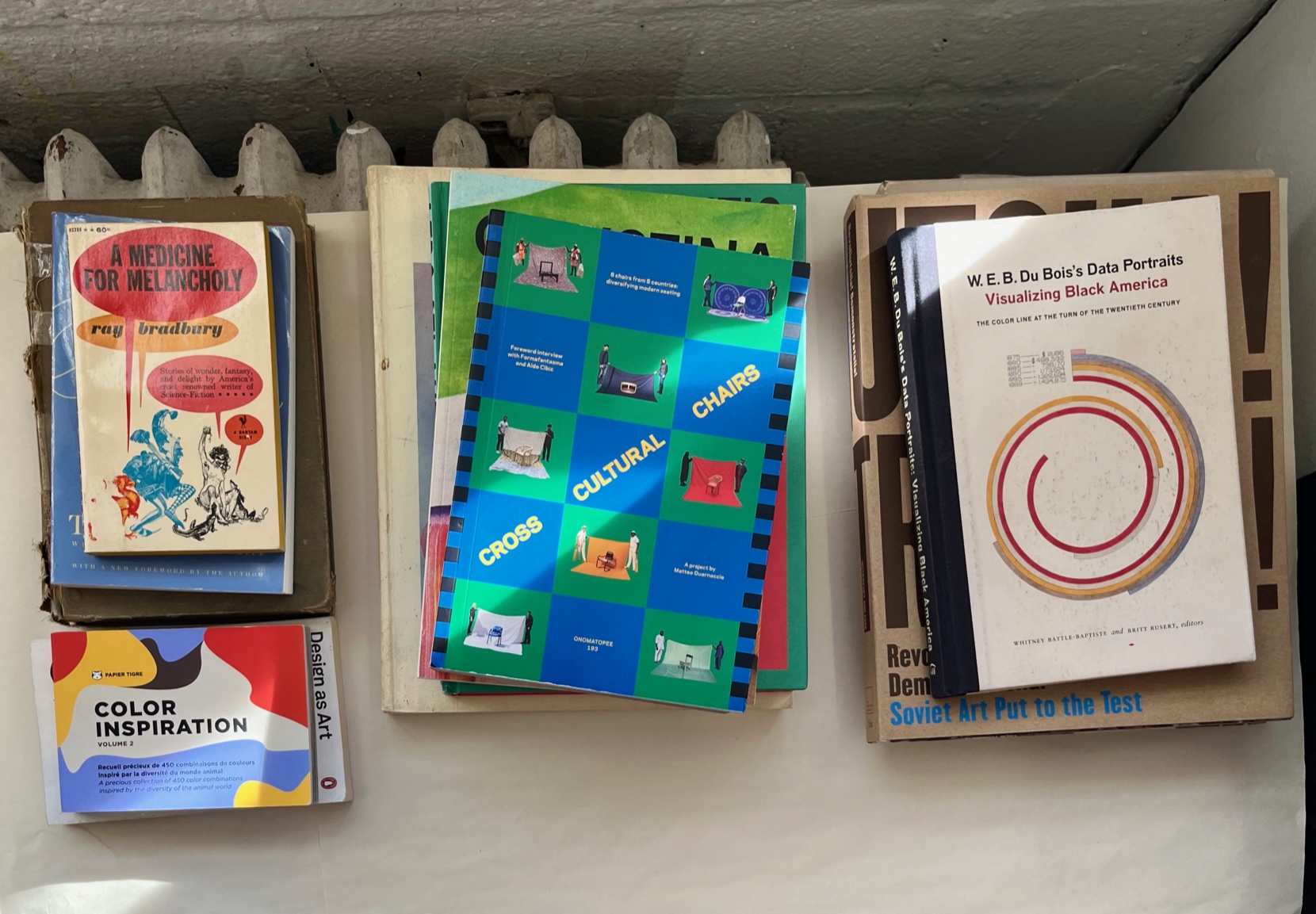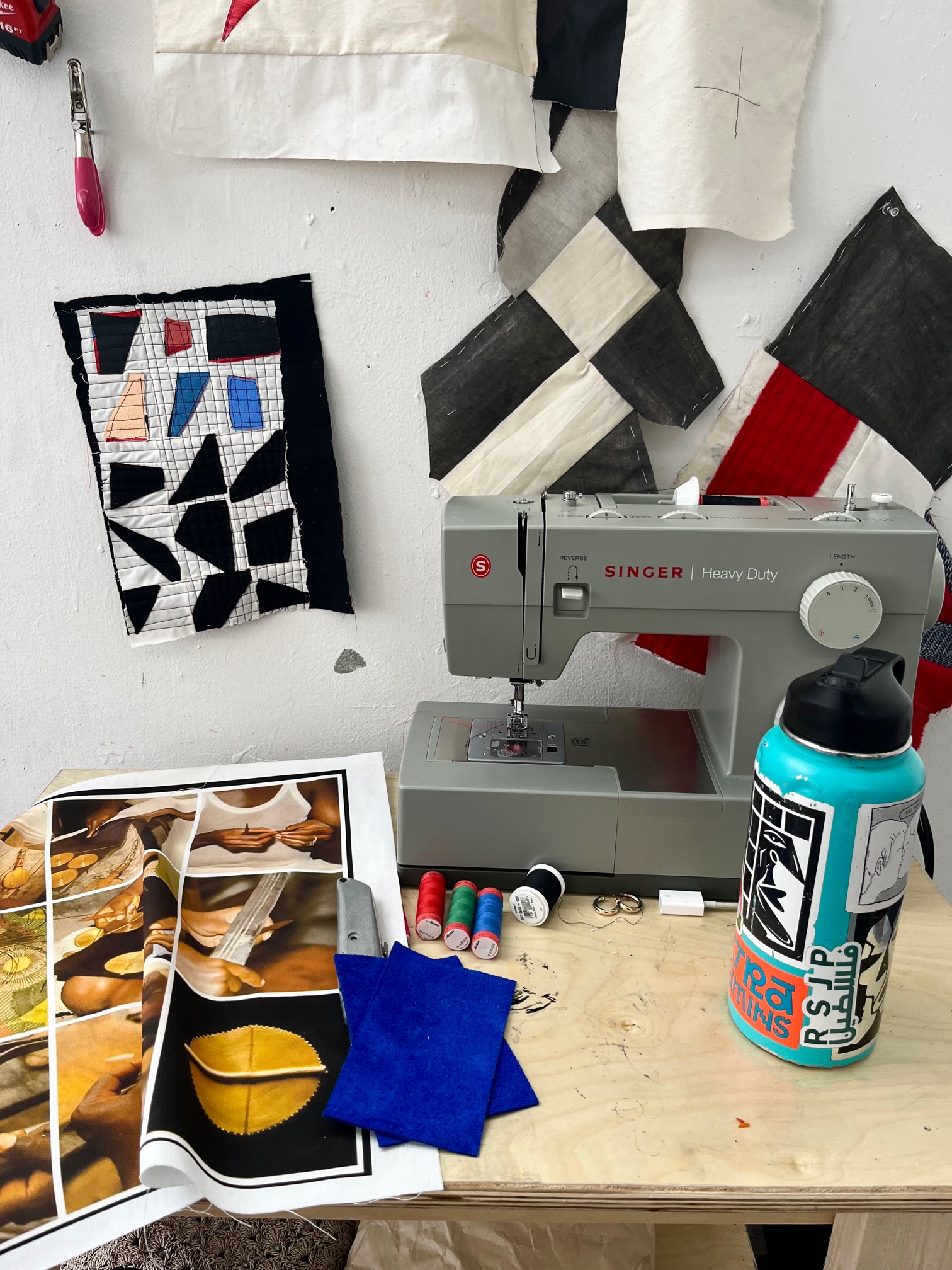Marin Griffith
Kobe Jackson
→MA GAC 2024
Marin Griffith
→ BFA PT 2024
November 8, 2023, 1:00 PM:
I met Marin in her studio on the 6th floor of College Building. Winter is in the air after a strangely warm spell for mid-November.
Favorite tool: sewing machine.


All images taken on site by Kobe Jackson
KJ Tell me a bit about your practice.
MG It’s about identity in ways that are obvious and not obvious—my Caribbean family, Blackness, womanhood, a bunch of things at once. There’s a lot of focus on being seen and heard and felt. I’m using language broad enough, hoping that anybody can get a piece of it. I’m interested in words right now and addressing connection and community through broad language. I’m trying to find the humanness in words, rather than the depiction of people now, so the figure is abstract. The stuff with figures is from summer and before the year started. These collage works are the newest and figures are resurfacing but in a different way. This had to be more literal but the next iteration of this piece plans on being more abstract.
KJ Where did you get these images?
MG I’m really into archives and picking through them. These images are from a couple Ebony magazines. I’m mostly focused on Black publications, Ebony, Jet, and whatever I can find online. There are ways to access archives that are inaccessible, by Google book previewing them. I have a bunch of originals, but I am a bit more precious about those. Some are from the RISD image archive. The piece itself and a lot of the work that I make that uses archives addresses the politics of archives, and the limit for Black representation in them. Some of these RISD archive images are addressing the lack of representation, specifically in the Caribbean diaspora. You can find yourself with a whole folder full of tourist imagery and not anything from the hands of Caribbean artists. I’m using archives as gap fillers between my family knowledge and what I can find to describe parts of me.
KJ Have you done much research on Theaster Gates’s work? He uses Ebony magazines.
MG Yeah, that is really important work, and I think he knows that. I did a project about him a while ago; I got really into his practice.
KJ What was the project about?
MG We were asked to create our own temporary genre of work or categorize it by using a couple examples of people and so Theaster Gates was one. I also had Kevin Beasley as another and the genre I created was artists who use specific material with context, to recontextualize things. So Kevin Beasley in that specific case got a lot of attention for the Whitney Biennal piece that was a cotton gin that he broke up into two different spaces. In one room you could see it functioning and in one room you could hear it functioning. He addressed how you can’t remove the context from the object, so an object like this will always have pretty serious implications in our history, even if you separate the work. Theaster Gates used the archives and community-centric work to represent a need within the community. I had a specific relationship with this teacher and I was frustrated for a lot of the year. I titled the work “Fuck You, Pay Us.” I didn't get any feedback on it though.
KJ That title is taken though.
MG It is taken, so I did a riff off of it with a subtitle, I don’t remember what the subtitle was, some ode to one of the original contexts. We never got any feedback so I don’t know how well it landed but there’s room to critique the class and the made up genre I created.
KJ What do you think of Theaster Gates’s work?
MG In addition to the Johnsons publishing work, there was a restoration of an old bank that became a community space. I was invested in what that meant for community. I come from a family of creative people who are involved in community. My family in Philly helps run a porch free food project that is sort of an iteration of the free brunch program that the Black Panthers originally started. They work on creating more food justice. I’m from Denver and we have a bookstore that’s all about liberation. It’s both a design store and a bookstore with the intersections of art, design, and liberation. We sell bell hooks and Bruno Munari and things like that. It’s important to me that a sense of community is conveyed in my work, for there to be some sort of outreach in it, or maybe it feels like a hug.


KJ What’s this stack?
MG It’s newsprint and super shitty craft paper. I love the quality of bad non-archival paper.
KJ Those things get sun-bleached really fast.
MG Super fast. Most of this piece is that craft paper and really acidic newsprint so it’s deteriorating in front of my eyes, but I’m really excited by that at the moment.
KJ This is a bold. . .
MG The thickness, yeah, I really like that profile. It’s a screenshot from a Nollywood (Nigerian Hollywood) film via instagram, off of an account that I love. I find myself using references from pop culture often sometimes more than academia, but usually both at the same time. I read a lot but besides that, sometimes Instagram really gets me.
KJ Are there any mediums that you haven’t mentioned yet?
MG I make a lot of posters for places, musicians, and friends. I was raised by graphic designers and typographers. I tried to run away from it and go to school for painting, which I pretended was rebellious, but I ended up making lots of things with words and type.

Kobe Jackson: artist’s artist, painter’s painter.
You can bring Marin Griffith your scraps, and she’ll love them like they are brand new.